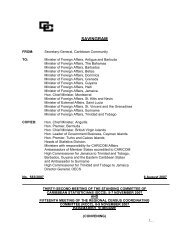National Census Report 2001, St. Vincent and the GrenadinesTable 5.4: Number and Percentage Employed Population 15 years or Older by OccupationalGroup, Age Group, and Sex, 2001Age GroupOccupational Group Total 15-19 20-24 25-29 30-34 35-39 40-44 45-49 50-54 55-59 60-64 65 +Total 35,036 1,877 4,749 5,020 4,832 5,341 4,456 3,121 2,296 1,343 923 1,078100.0 100.0 100.0 100.0 100.0 100.0 100.0 100.0 100.0 100.0 100.0 100.00Legislator/Manager 6.12 0.00 2.38 3.69 4.80 6.05 7.05 9.48 10.93 11.47 12.35 14.94Professional 9.92 0.00 6.70 8.84 12.13 11.78 13.20 12.72 13.41 7.59 5.85 4.73Technical 4.94 0.80 6.40 6.24 5.44 4.87 5.33 5.13 4.14 3.28 1.73 2.23Clerical 9.30 13.26 17.77 14.42 8.90 6.78 6.15 5.96 4.36 3.50 2.17 2.14Services/Sales 14.59 18.81 20.70 18.95 15.54 12.39 12.14 11.57 10.71 9.38 7.37 6.40Skilled/Agricultural 11.28 5.70 4.42 6.51 9.27 12.07 13.01 13.07 14.94 19.73 29.79 32.00Craft 13.58 15.08 13.67 13.92 14.76 15.47 14.07 11.86 12.33 11.39 9.86 6.03Machine Operator 6.92 2.34 5.87 8.45 8.63 7.28 6.13 6.89 7.88 6.48 7.26 4.17Elementary 20.50 26.11 19.75 17.51 19.00 21.92 21.12 20.79 18.77 24.13 21.89 22.17Not Stated 2.85 17.90 2.34 1.47 1.53 1.39 1.80 2.53 2.53 3.05 1.73 5.19Male 21,518 1,312 2,888 2,995 2,960 3,192 2,654 1,842 1,426 884 620 745100.0 100.0 100.0 100.0 100.0 100.0 100.0 100.0 100.0 100.0 100.0 100.0Legislator/Manager 5.04 0.00 1.66 3.14 3.61 4.57 6.14 8.41 9.68 9.62 9.19 12.35Professional 7.37 0.00 4.99 5.76 8.58 8.40 9.38 10.26 11.50 7.81 6.45 4.84Technical 4.09 0.69 4.36 5.18 4.66 3.95 4.94 4.79 3.72 3.05 2.10 2.01Clerical 3.32 5.56 6.89 5.24 3.14 1.82 1.96 1.57 1.82 1.24 0.97 1.07Services/Sales 11.97 14.56 18.05 15.96 11.76 9.27 10.36 9.93 9.13 8.82 6.45 4.83Skilled/Agricultural 15.27 7.55 6.61 9.71 13.01 17.01 17.41 17.64 19.14 23.30 35.65 38.79Craft 20.08 20.50 20.53 21.50 22.40 23.59 21.48 17.37 16.76 15.50 12.58 7.25Machine Operator 10.42 2.97 8.83 13.06 12.94 11.12 9.72 10.64 12.41 9.62 10.48 5.24Elementary 19.38 33.08 25.24 18.70 18.34 18.64 16.50 16.73 13.39 16.97 14.52 17.85Not Stated 3.06 15.09 2.84 1.74 1.56 1.63 2.11 2.66 2.45 4.07 1.61 5.77Female 13,518 565 1,861 2,025 1,872 2,149 1,802 1,279 870 459 303 333100.0 100.0 100.0 100.0 100.0 100.0 100.0 100.0 100.0 100.0 100.0 100.0Legislator/Manager 7.83 0.00 3.49 4.49 6.67 8.24 8.38 11.02 12.99 15.03 18.81 20.72Professional 13.99 0.00 9.35 13.38 17.74 16.80 18.81 16.26 16.55 7.19 4.62 4.50Technical 6.30 1.06 9.56 7.80 6.68 6.24 5.94 5.63 4.83 3.70 0.99 2.71Clerical 18.84 31.16 34.66 28.00 18.00 14.15 12.33 12.28 8.51 7.84 4.62 4.50Services/Sales 18.75 28.67 24.83 23.36 21.53 17.03 14.76 13.92 13.32 10.46 9.24 9.91Skilled/Agricultural 4.93 1.42 1.02 1.78 3.37 4.75 6.55 6.48 8.05 12.85 17.82 16.82Craft 3.25 2.48 3.01 2.72 2.67 3.40 3.16 3.91 5.06 3.49 4.29 3.30Machine Operator 1.32 0.88 1.29 1.63 1.82 1.57 0.83 1.49 0.46 0.44 0.66 1.81Elementary 22.27 9.91 11.23 15.75 20.02 26.80 27.91 26.66 27.59 37.91 36.96 31.83Not Stated 2.52 24.42 1.56 1.09 1.50 1.02 1.33 2.35 2.64 1.09 1.99 3.9066
National Census Report 2001, St. Vincent and the Grenadines5.4.3 IndustryThe Wholesale and Retail Trade industry accounted for the largest share (16.88 per cent) of theemployed population, while Agriculture and Construction industries followed with 13.73 and10.48 per cent respectively (Table 5.5). This distribution differed by sex, with the males mainlyengaged in the Agriculture (17.72 per cent) and Construction (16.23 per cent), while the femaleswere engaged in Wholesale Sale and Retail Trade (22.30 per cent) and Education (12.61 percent).The youth population was mainly engaged in Wholesale and Retail Trade, Construction andManufacturing. Among those in the 15 to 19 age group, almost one in ten of them (9.59 percent) were employed in the agriculture sector compared to 6.91 per cent in the 20 to 24 agegroup and 8.75 percent in the 25 to 29 age group. These rates are the lowest compared to anyother age group that worked in the agriculture sector. As the age increased the likelihood ofworking in the agriculture industry also increased. The 35 year or older population was mainlyengaged in this sector. Traditionally, males have been more attracted to this sector and thetradition has continued with 17.72 per cent males compared to 7.40 per cent females engaged inagriculture.These key industries that the employed labour force was mainly engaged in have been among theleading ones that have contributed to the economy in St. Vincent and the Grenadines. In 2001,wholesale and retail trade contributed 18.57 per cent of GDP (Statistical Office, 2004). No otherindustry contributed as much to GDP, except government services (19.28 per cent). That sameyear, the agriculture industry’s contribution to GDP was 9.62 per cent. Since then, this sector’scontribution to the economy has gradually declined in absolute value as well as, in its percentagecontribution to GDP. The agriculture industry has experienced the harshest changes with the lossin preferential treatment and lowering of world prices in bananas, and the effects of naturaldisasters. The construct industry contributed 11.89 per cent of GDP in 2001. Although thetransport industry accounted for only 7.44 per cent of the employed labour force, its contributionto GDP was 13.82 per cent. This sector is not as labour intensive as the Agriculture andConstruction industries.67
- Page 1:
CARICOM CAPACITY DEVELOPMENTPROGRAM
- Page 4:
National Census Report 2001, St. Vi
- Page 7 and 8:
National Census Report 2001, St. Vi
- Page 9 and 10:
National Census Report 2001, St. Vi
- Page 11 and 12:
National Census Report 2001, St. Vi
- Page 13 and 14:
National Census Report 2001, St. Vi
- Page 15 and 16:
National Census Report 2001, St. Vi
- Page 17 and 18:
National Census Report 2001, St. Vi
- Page 19 and 20:
National Census Report 2001, St. Vi
- Page 21 and 22:
National Census Report 2001, St. Vi
- Page 23 and 24:
National Census Report 2001, St. Vi
- Page 25 and 26:
National Census Report 2001, St. Vi
- Page 27 and 28:
National Census Report 2001, St. Vi
- Page 29 and 30:
National Census Report 2001, St. Vi
- Page 31 and 32:
National Census Report 2001, St. Vi
- Page 33 and 34: National Census Report 2001, St. Vi
- Page 35 and 36: National Census Report 2001, St. Vi
- Page 37 and 38: National Census Report 2001, St. Vi
- Page 39 and 40: National Census Report 2001, St. Vi
- Page 41 and 42: National Census Report 2001, St. Vi
- Page 43 and 44: National Census Report 2001, St. Vi
- Page 45 and 46: National Census Report 2001, St. Vi
- Page 47 and 48: National Census Report 2001, St. Vi
- Page 49 and 50: National Census Report 2001, St. Vi
- Page 51 and 52: National Census Report 2001, St. Vi
- Page 53 and 54: National Census Report 2001, St. Vi
- Page 55 and 56: National Census Report 2001, St. Vi
- Page 57 and 58: National Census Report 2001, St. Vi
- Page 59 and 60: National Census Report 2001, St. Vi
- Page 61 and 62: National Census Report 2001, St. Vi
- Page 63 and 64: National Census Report 2001, St. Vi
- Page 65 and 66: National Census Report 2001, St. Vi
- Page 67 and 68: National Census Report 2001, St. Vi
- Page 69 and 70: National Census Report 2001, St. Vi
- Page 71 and 72: National Census Report 2001, St. Vi
- Page 73 and 74: National Census Report 2001, St. Vi
- Page 75 and 76: National Census Report 2001, St. Vi
- Page 77 and 78: National Census Report 2001, St. Vi
- Page 79 and 80: National Census Report 2001, St. Vi
- Page 81 and 82: National Census Report 2001, St. Vi
- Page 83: National Census Report 2001, St. Vi
- Page 87 and 88: National Census Report 2001, St. Vi
- Page 89 and 90: National Census Report 2001, St. Vi
- Page 91 and 92: National Census Report 2001, St. Vi
- Page 93 and 94: National Census Report 2001, St. Vi
- Page 95 and 96: National Census Report 2001, St. Vi
- Page 97 and 98: National Census Report 2001, St. Vi
- Page 99 and 100: National Census Report 2001, St. Vi
- Page 101 and 102: National Census Report 2001, St. Vi
- Page 103 and 104: National Census Report 2001, St. Vi
- Page 105 and 106: National Census Report 2001, St. Vi
- Page 107 and 108: National Census Report 2001, St. Vi
- Page 109 and 110: National Census Report 2001, St. Vi
- Page 111 and 112: National Census Report 2001, St. Vi
- Page 113 and 114: National Census Report 2001, St. Vi
- Page 115 and 116: National Census Report 2001, St. Vi
- Page 117 and 118: National Census Report 2001, St. Vi
- Page 119 and 120: National Census Report 2001, St. Vi
- Page 121 and 122: National Census Report 2001, St. Vi
- Page 123 and 124: National Census Report 2001, St. Vi
- Page 125 and 126: National Census Report 2001, St. Vi
- Page 127 and 128: National Census Report 2001, St. Vi
- Page 129 and 130: National Census Report 2001, St. Vi
- Page 131 and 132: National Census Report 2001, St. Vi
- Page 133 and 134: National Census Report 2001, St. Vi
- Page 135 and 136:
National Census Report 2001, St. Vi
- Page 137 and 138:
National Census Report 2001, St. Vi
- Page 139 and 140:
National Census Report 2001, St. Vi
- Page 141 and 142:
National Census Report 2001, St. Vi
- Page 143 and 144:
National Census Report 2001, St. Vi
- Page 145 and 146:
National Census Report 2001, St. Vi
- Page 147 and 148:
National Census Report 2001, St. Vi
- Page 149 and 150:
National Census Report 2001, St. Vi
- Page 151 and 152:
National Census Report 2001, St. Vi
- Page 153 and 154:
National Census Report 2001, St. Vi
- Page 155 and 156:
National Census Report 2001, St. Vi
- Page 157 and 158:
National Census Report 2001, St. Vi
- Page 159 and 160:
National Census Report 2001, St. Vi
- Page 161 and 162:
National Census Report 2001, St. Vi
- Page 163 and 164:
National Census Report 2001, St. Vi
- Page 165 and 166:
National Census Report 2001, St. Vi










